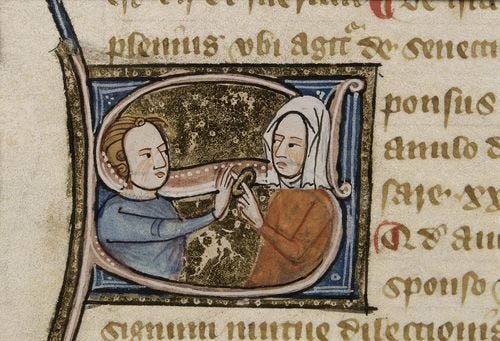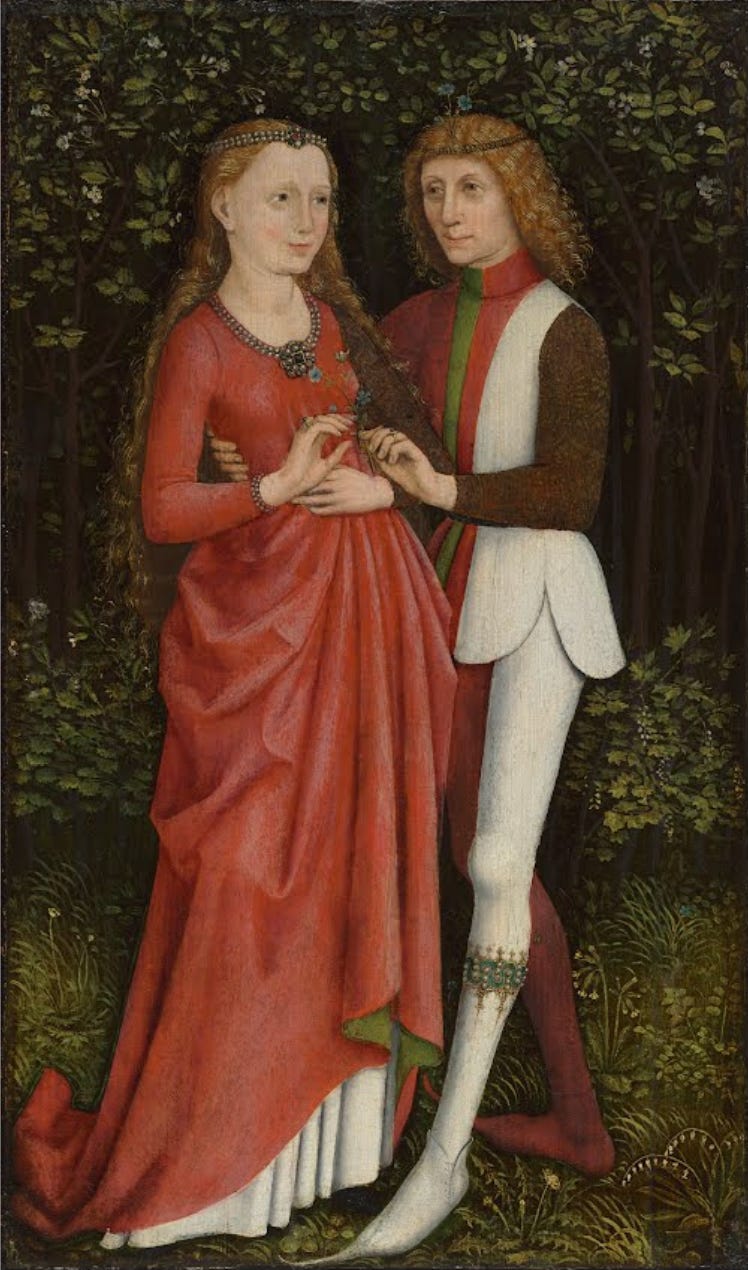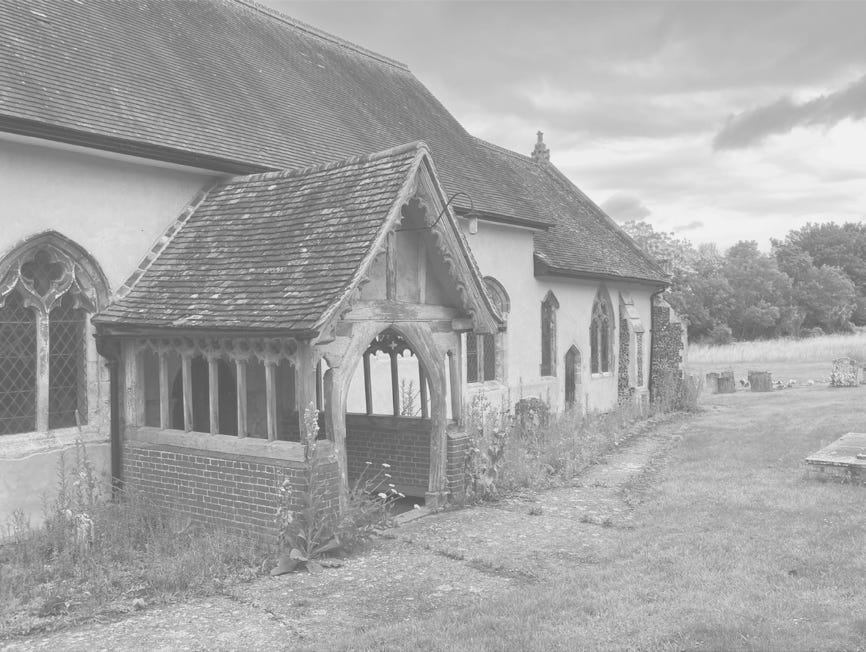"2 become 1": Did the Spice Girls Plagiarise Medieval Priests?
“If you wannabe my lover, you gotta get with my friends”. Age 12, bouncing around with my pals, we belted out the Spice Girls with total conviction. But were we inadvertently celebrating the revolutionary reforms of the medieval Western Church?
In one of history’s boldest social engineering projects, the Church attacked clan power by banning cousin marriages, while simultaneously elevating a radical new form of loyalty: the sacred bond between husband and wife.
“2 become 1” isn’t just a chart-topper, it’s the culmination of centuries of theological contestation and cultural evolution!
Caution: the Medieval period is super messy. In the absence of strong institutions, there was much heterogeneity. Given mass illiteracy, it’s quite impossible to know what ordinary people thought or felt. Our evidence base is patchy and partial - heavily reliant on prominent priests, canon lawyers, and court records. Your critique is always welcome!
The Western Church's Cultural Evolution
The Early Church’s expectations of the laity were low
Before 1100, the Church maintained minimal expectations of the laity beyond basic adherence to Christianity. “Just don’t be pagan”. The clergy was more focused on the warrior class - securing their material support and preventing attacks on church property.
Marriage itself was viewed with theological suspicion. Augustine’s legacy cast a long shadow: he viewed sexual desire as a dangerous force that pulled human longing away from God toward earthly pleasures. Peter Lombard warned that “Every too-ardent lover of his own wife is an adulterer.” Marriage served to contain potentially dangerous passion. “It is better to marry than to burn”, said St. Paul.
Given the Church’s disregard in the laity and discomfort with marriage, its involvement was minimal. Couples might exchange vows anywhere from woodlands to taverns, even in bed.. One 11th century German poem described a knightly family’s wedding occurring without a priest. As historian Diamond MacCulloch observes,
“It is one of the greatest forgotten realities of Christian history that for centuries, from the first years of the Church, there was no such thing as a church wedding, and when church weddings did start appearing, patchily, in the fourth century, the Church did not offer them to all the faithful.”
If clerics were involved in weddings, their language drew heavily from the Old Testament - featuring stories of Abraham, Isaac, and Jacob.
Among landed elites, marriage was essentially a contract between men - typically between the suitor and his future father-in-law. In Iceland and elsewhere, the deal was sealed by “handaband” - the joining of hands between the groom and the woman’s male guardian.
The Church started to Meddle
As cities grew, populations rose and education improved, the Church became more actively involved in people’s lives. The Fourth Lateran Council of 1215 marked a turning point, establishing parish priests as active shepherds of lay morality, ensuring orthodox conformity.
A Two-Pronged Attack!
The Church launched an unprecedented campaign to reshape family structures through two parallel strategies: undermining clan-based marriages while elevating conjugal love to sacred status.
Their first move targeted clan power directly by prohibiting cousin marriage within four degrees of kinship - restrictions visualised in intricate "tables of consanguinity." But destruction wasn’t enough; they also nurtured an alternative loyalty. This led to their second strategy: redefining marriage itself as sacred.
Marriage was Redefined as a Sacrament!
Canon lawyers achieved this by locating marriage's sacred moment not in the wedding night but in mutual consent. The couple's freely spoken vows became the sacramental sign, parallel to water in baptism or bread in communion. Under the principle of solus consensus, only freely given consent could create valid marriage - a coniunctio animorum (union of wills).
This new vision of marriage encompassed both spiritual and physical union. From the 11th century, Western canon lawyers ‘revived’ Saint Paul's concept of the ‘marital debt’ - husbands and wives owed each other sexual fulfillment. Thomas Aquinas went further in the 13th century, arguing that “a man loves his wife principally by reason of the carnal meeting.” In his view, a nuclear home and fantastic sex would enable “maximum friendship”. The key concept was “adunatio” (becoming united).
Opposition may have strengthened this positive view of marriage. When 12th century radical religious groups like the Cathars declared all marriage evil and all sexuality sinful - claiming sex with your wife was no different than with a concubine - the Church found itself defending marital intimacy. Their extreme rejection of the physical world may have pushed Catholic thinkers to view marriage more positively!

This theological revolution transformed attitudes toward marriage
The Franciscan preacher Guibert de Tournai celebrated how ‘husband and wife love one another is more vehement than all carnal loves’. Saint Bonaventure echoed this sentiment:
“In marriage … there is mutual love and therefore mutual zeal, and therefore singleness…. For there is something miraculous in a man finding in one woman a pleasingness which he can never find in another.”
In 1547, the Council of Trent formally declared that marriage was one of seven essential sacraments, conferring divine grace just like baptism or communion. Yet unlike other sacraments, couples took an active role in their own vows, with priests merely witnessing and blessing.
This Western Christian vision of marriage as an exclusive, loving partnership stood in sharp contrast to ancient Roman or Greek marriages, which included concubines and slaves. It also diverged from Eastern Orthodoxy. Byzantine lawyers maintained a more negative view of sex. Love and marriage remained quite distinct. In Western Europe, husband and wife were becoming one unit - spiritually and legally.
The Mystery of the Wooden Porch
Ever wondered why medieval churches feature wooden porches?
Hidden in plain sight, this architectural feature actually tells the story of how marriage gradually became sacred! In 1220s Salisbury, wedding ceremonies were required to take place ‘ante ostium ecclesiae’ - in front of the cathedral. Soon, churches across England added wooden porches - marking them distinct from the main stone church. These architectural features weren’t just a hot trend – they marked the gradual incorporation of marriage into the Church's sacred framework.
Only with the Reformation did weddings move entirely inside.
Put a Ring on It
Picture the scene: a couple standing under wooden arches, in full view of their community, exchanging vows. The priest would first ask if anyone knew of any impediments – like the forbidden cousin marriage. Then came another ritual: placing rings on the fourth finger. Why? A 14th-century preacher explained,
“put and set by the husband upon the fourth finger of the woman, to show that a true love and cordial affection be between them, because.. there is a vein coming from the heart of a woman to the fourth finger, and therefore the ring is put on the same finger, so that she should keep unity and love with him, and he with her.”
The couple then exchanged vows and celebrated nuptial mass. In the age of friars, these church sermons were powerful vehicles of mass communication. Now, listen to this 14th Century Mass and tell me the Spice Girls weren’t taking notes…
“to join, unite, and combine these two persons by the holy sacrament of matrimony…. Which sacrament of matrimony is of this virtue and strength that these two persons who now are two bodies and two souls, during their lives together shall be . . . one flesh and two souls”.
Both parties declared the same marriage vows:
“I take thee here Alice/William as my lawful wife/husband, to have and to hold all the days of my life, if holy church allow it, and to this I pledge thee my troth [loyalty]”.

Young Love vs. Family Control?
While the Western Church championed mutual consent and marital love, reality proved complicated. Medieval Europe was remarkably diverse. In an era of limited literacy, basic technology and weak institutional reach, official doctrine often differed from local practice. Remote villages maintained idiosyncratic customs, local priests interpreted rules differently, and communities found ways to adapt official policies to their wants. That all said, the existing literature points to important variation by class.
For nobles, marriage was highly strategic, moving women like pieces on a chess board. Personal feelings played second fiddle to political alliances.
The merchants and gentry played by slightly different rules. Marriage was still a collective project, with family members, business contacts, and local connections all helping to identify potential matches. But there was more room for personal preference. Take the first surviving Valentine’s letter from 1477: Margaret Brews addresses John Paston as “most dearly beloved Valentine”, while simultaneously negotiating her dowry, pleading with him to accept a smaller sum. (Spoiler: they successfully married within the year).
Peasants and artisans faced a different set of hurdles. Young couples needed significant savings to establish their households, often working for years as servants or apprentices. Urban working women often experienced greater independence. While parents offered advice, these youth relied heavily on their own social networks - friends, employers, and neighbours - to find partners.
But not everyone made it to the altar. 20% of women never married - not by choice, but because of back-breaking poverty.

Is the Nuclear Family Toxic?
Western Europe slowly developed a marriage pattern that set it apart from the rest of the world: weak kinship, mutual consent, a glimmer of love, and independent nuclear households. This system differed fundamentally from patrilocal societies, where trusted networks were consolidated by brides joining their husbands’ extended families, and matrilocal ones, where couples lived among the wife’s kin.
My globally comparative research suggests that nuclear families had profound cultural implications. Since marriages are not restricted to kin, there is a far larger pool of permissible matches. While endogamous societies closely police young girls ensure cousin or caste marriage, European youth could search more widely. Given greater freedoms, men and women often spent years working in service – a crucial period of youthful independence.
Nuclear families also created more potential for marital intimacy. Rather than raising sons to serve their parents, European families prepared them for independence with their wives. Nuclear couples had to chart their own course, strategising as a small unit and cooperating jointly.
However - and this is crucial - compared to matriliny, nuclear wives are far more vulnerable to violence. Rather than living on her family land, surrounded by protective kin, the nuclear wife is alone. Mothers secured their children’s survival by ensuring their husband’s support. This isolation and lack of exit options made women more vulnerable to abuse – especially in an era of bare-subsistence wages, where English laws of coverture gave husbands control over their wives’ property, while churches condemned divorce and authorities permitted “reasonable correction”.
The egalitarian notion of ‘mutual love’ - where each partner cherishes the other’s wants and welfare - was thus thwarted. This reciprocal sentiment simply could not thrive amid status hierarchies, where one party expected to be served by another, or where mothers were so desperate for their husband’s loyalty that they constantly acquiesced.

Violence and Power
Medieval marriage was no picnic. Towns fomented a potent mix: rampant misogyny and patriarchy in church teachings, mockery of ‘weak’ husbands in tavern culture, and the constant stresses of poverty. Ale - the daily brew - likely exacerbated discord.
The Polish Dominican Peregrinus captured this dynamic perfectly:
“I fear that there are many husbands who are so angry after a visit to an inn that they enjoy beating their wives. They do not dare to strike those who insulted them because they know that, if they do, they will be beaten in return.
Patriarchal culture made men’s pride conditional on dominance. Hierarchy was enshrined in the wedding itself - at English ceremonies, only women promised to be “bonour and buxum” (good and obedient), viewing their husbands as “mon baron”. Husbands had the right to apply ‘corrective’ violence. Failure to discipline one’s wife opened a man to ridicule. Popular ballads featured that ultimate horror show: the world turned upside down, with a dominant wife.
Institutional Responses
Clerics differed. At one end of the spectrum, the Polish Dominican Peregrinus urged husbands to “love his wife without speaking any evil words to her or striking her”. But others were more disciplinarian. Thomas Chobham’s 1215 manual advised confessors that husbands should “moderately and decently correct” foolish wives.
The Sienese Rules of Marriage similarly laid out a graduated approach, culminating in beating your wife with a stick:
“When you see your wife commit an offence… first correct the wrong lovingly and pleasantly, and sweetly teach her not to do it again….
But if your wife is of a servile disposition and has a crude and shifty spirit, so that pleasant words have no effect, scold her sharply, bully, and terrify her.
And if this still doesn’t work … take up a stick and beat her soundly … not in rage, but out of charity and concern for her soul”.
Nice.
Legal codes were equally permissive. The 13th century French law code, Customs of Beauvais, explicitly stated: “In a number of cases men may be excused for the injuries they inflict on their wives, nor should the law intervene. Provided he neither kills nor maims her, it is legal for a man to beat his wife when she wrongs him.” As Florentines quipped, “A good woman and a bad one equally require the stick!”.
Wives were widely expected to respect his authority. One 14th century preacher’s manual declared that a wife should remain silent to protect her husband’s honour. St Augustine praised his mother for quietly enduring his father’s rage and infidelity. Popular conduct literature like “What the Goodwife Taught Her Daughter” reinforced submission: “Make thou no jangling”, “sweet of speech shall thou be”, “be thou no chider”.
Status Hierarchies
Laws, written by men, encoded male dominance. The rules of coverture made a husband legally responsible for his wife’s misbehaviour, thereby encouraging his duty as disciplinarian. England’s 1352 statute classified husband-killing as petty treason - equivalent to a servant killing their master - punishable by being burnt alive. Wife-killing, meanwhile, was treated as ordinary homicide.
Court records show men successfully invoking their wives’ “disobedience” to justify violence. William Hyndeley in 1475 cited his wife’s “opprobrious, contentious, scolding and vexatious words”. Richard Styward in 1488 blamed his wife's “many opprobrious and despicable words”. Case after case validated the idea that women’s deviance justified men’s fists.
Courts and Community Protection
Friends, neighbours and natal families sometimes formed what I call “reverse dominance coalitions”. Brothers and fathers repeatedly sought to protect female kin. Neighbours rescued Margery Nesfeld from being stabbed, and pulling Henry from Cecilia Wyvell’s body. Local courts sometimes required violent husbands to provide “sureties” - respected community members who would guarantee good behaviour under financial penalty. Medieval England also scolded abusers with public humiliation.
Courts commanded men to stop and women to obey
Courts didn’t necessarily turn a blind eye to violence; rather, their solution was to encourage female obedience. When Thomas Tebbe repeatedly beat and expelled his wife, the court blamed her “rebellion”. Their solution? Order him to stop beating, and command her to show proper obedience. When Thomas Felmingham’s wife sought help after severe beating, the rector first tried reconciliation. As Thomas Rigton faced charges of long-term abuse, they made his wife Ebote swear to “humbly obey her said husband”. Richard Epworth was found guilty of beating Margaret “fiercely and inappropriately” - the court threatened him with a fine and 12 floggings but her with 24 if she failed to improve.
Death threats were not necessarily sufficient for separation. When Margery of Longford begged protection in the 1560s, fearing for her life, authorities simply “persuaded her to agree with her husband”. Alice appealed to the court at York in 1382 saying she feared for her life, but the court insisted on co-residence, while threatening the husband with 12 floggings around the cathedral church. Even after Thomas explicitly “feared he should” give his wife a “mortal or deadly wound”, courts insisted on unification.
The tragic case of Anne Feales of Yorkshire illustrates the deadly consequences of this approach. She told her neighbours that “her husband would either kill her or hang her, he having a knife in one hand and a rope in the other”. Reportedly, he had already put a rope around her neck three times nearly to the point of death. When her body was later found hanged in their house, neighbours immediately suspected her husband Marmaduke, despite his claim of suicide.
While the courts certainly impeded exit, it would be inaccurate to imply that most women were desperately trying to leave, stopped only by Canon Law. In Paris, Ely and York, the primary plaintiffs in matrimonial cases were women - desperately seeking to enforce marriage and men’s commitment. Most women wanted men to stay - likely reflecting deep insecurity.
While the Medieval period was incredibly patriarchal, the Western Church simultaneously created latent assets for gender equality. When young people were raised for independence rather than clan loyalty, when they could choose their own partners, and when their marriages were built on mutual consent rather than family alliance, this sowed the seeds of modern romantic love.
Fast-forward eight centuries - flicking through the Protestant Reformation, Secular Enlightenment, Industrial Revolution, female novelists and feminists activism, we get to….
The Spice Girls
Listening to the best tunes of the 1990s, I realise that the Spice Girls’ entire catalogue is effectively stolen from the Medieval playbook, set to a catchier beat.
“Wannabe”, their breakthrough hit that sold 5 million copies worldwide, strongly asserts female choice, men’s demonstration of devotion, and that a woman maintains her social network even after marriage. This sharply contrasts with patrilocal arranged marriages, where brides cry upon leaving their natal family.
Female autonomy pops up again in “Too Much”: “What part of no don't you understand?”
“2 Become 1” is straight up 14th century copy-paste:
“Say You’ll Be There” - essentially a modern version of 14th century vows, complete with promises of commitment and loyalty.
“Who Do You Think You Are?” is equally Medieval. A man must demonstrate his worth to a woman, who is the ultimate arbitrator:
If You Wanna Be My Lover...
The medieval Church’s marriage reforms were nothing short of revolutionary. By banning cousin marriage, they weakened clans, thereby nurturing greater individualism and democracy.
They also nurtured a radically different kind of loyalty. By elevating conjugal love to sacred status and requiring mutual consent, the Western Church laid the groundwork for modern ideas about romantic love.
So the next time you hear “Wannabe”, remember: you’re not just grooving to an awesome tune. In truth, it’s the lyrical footprint of of a radical medieval campaign which transformed love and loyalty.

Fabulous Books & Papers
Sara M. Butler. 2007 “The Language of Abuse: Marital Violence in Later Medieval England”
Diarmaid MacCulloch, 2024, “Lower than the Angels: A History of Sex and Christianity”
Shannon McSheffrey. 2006 “Marriage, Sex, and Civic Culture in Late Medieval London”
David d'Avray, 2008 “Medieval Marriage: Symbolism and Society”
Philip L. Reynolds, 2016 “How Marriage Became One of the Sacraments”
John H. Arnold, 2005 “Belief and Unbelief in Medieval Europe”













What a delight! I did not expect to learn about this connection between the Spice Girls and 13th century theology, but I now know that it’s exactly what I want/what I really really want.
I think you may have slightly underplayed the influence of Jerome vs. Augustine.